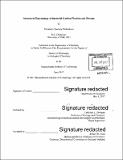Structural enzymology of bacterial carbon fixation and storage
Author(s)
Wittenborn, Elizabeth Charlotte, 1988-
DownloadFull printable version (14.58Mb)
Other Contributors
Massachusetts Institute of Technology. Department of Chemistry.
Advisor
Catherine L. Drennan.
Terms of use
Metadata
Show full item recordAbstract
As concerns about sustainable energy and climate change grow, there has been an ever growing interest in understanding how Nature sequesters and uses carbon. In this thesis, I present X-ray crystal structures of two central players in bacterial carbon fixation and storage: carbon monoxide dehydrogenase (CODH) and polyhydroxyalkanoate synthase (PhaC). CODH is a key component of the Wood-Ljungdahl pathway of carbon fixation, catalyzing the reversible reduction of CO₂ to CO, and has garnered interest as a possible tool in environmental remediation and biofuels production. Practical challenges to applications of CODH include oxygen sensitivity of the catalytic metallocluster cofactors and incomplete assembly of the active site metallocluster in heterologous systems. To address these pitfalls, I have determined crystal structures of the CODH from Desulfovibrio vulgaris revealing that a solvent-exposed iron-sulfur cluster in the enzyme is a critical contributor to irreversible oxidative damage and that damage can be avoided through variations in cluster type at this position. In a separate series of crystal structures, I have also visualized dramatic conformational dynamics within the unique Ni-Fe-S cluster active site of CODH that could play a role in cluster stability and assembly as well as in avoidance of oxidative degradation. By providing a better understanding of oxygen sensitivity and cluster assembly, we hope to increase the feasibility of using CODH in practical applications. PhaC catalyzes the polymerization of hydroxyalkyl-coenzyme A substrates as a means of carbon storage in many bacteria. The resulting polymers can be used to make biodegradable materials with properties similar to those of thermoplastics or elastomers and are an environmentally friendly alternative to traditional petroleum-based plastics. To provide insight into the mechanism of hydroxyalkanoate polymerization, I have determined the first crystal structure of the catalytic domain of PhaC. The structure reveals the molecular architecture of the active site including key amino acid interactions that play likely roles in facilitating catalysis, as well as putative substrate entrance and product egress channels. This work lays the foundation for further biochemical and structural characterization of PhaC, and for engineering efforts for the production of cost-effective and environmentally sustainable materials.
Description
Thesis: Ph. D. in Biological Chemistry, Massachusetts Institute of Technology, Department of Chemistry, 2017. Cataloged from PDF version of thesis. Vita. Includes bibliographical references.
Date issued
2017Department
Massachusetts Institute of Technology. Department of ChemistryPublisher
Massachusetts Institute of Technology
Keywords
Chemistry.